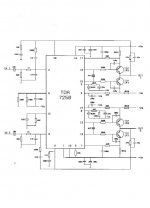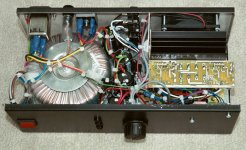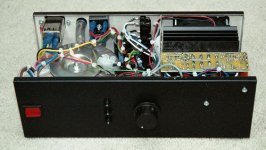Why should there be any problems running a solid state amplifier with no load on the output? I know tube amps need loading at all times, I think to prevent voltage spikes being fed into the output stage due to ringing in the transformer.
Some people may remember reading about my difficulties with the Velleman K4005 amp - I have since been told that the amp kept overheating because I was conducting my tests with the unit unloaded. Is this poor design or a common phenomenon? I run my P3A amp in “mute” mode (i.e. no speakers connected) for hours on end, and it doesn’t bat an eyelid. Can someone explain this more fully to me?
Thanks,
Tim.
Some people may remember reading about my difficulties with the Velleman K4005 amp - I have since been told that the amp kept overheating because I was conducting my tests with the unit unloaded. Is this poor design or a common phenomenon? I run my P3A amp in “mute” mode (i.e. no speakers connected) for hours on end, and it doesn’t bat an eyelid. Can someone explain this more fully to me?
Thanks,
Tim.
There should be absolutly no problems running solid state amp without load. tubes are the other story..
Yeah, 's what I thought. The technician I spoke to at my eletronics supplier justified the Velleman amp's problem by saying many professional amplifiers have circuits to simulate minimum loading. I don't remember seeing any of these circuits, and I have run several PA amps with only one channel loaded or not loaded at all (i.e. in a redundant amp in a large rack), with no difficulties. Does anybody have any further thoughts?
I've never had any problems with unloaded amps before; but I've heard somewhere that older amps may have problems. I don't know if they're referring to tube amps or solid state amps.
HB.
HB.
Running Amps Unloaded
Running valve amps in an unloaded state can generate quite large voltages within the transformer windings, breaking down the insulation.
When I worked with auto electrics, running an alternator without a battery load usually burnt out the stator and the explanation the Lucas technicians gave was that the harmonics generated a voltage increase greater than the insulation could withstand.
Of course, transistor amplifiers are quite safe, or should be, without a load.
Cheers,
Les
Running valve amps in an unloaded state can generate quite large voltages within the transformer windings, breaking down the insulation.
When I worked with auto electrics, running an alternator without a battery load usually burnt out the stator and the explanation the Lucas technicians gave was that the harmonics generated a voltage increase greater than the insulation could withstand.
Of course, transistor amplifiers are quite safe, or should be, without a load.
Cheers,
Les
The circuit in solid-state amplifiers to simulate a load in unloaded conditions is the output Zobel network. It is a resistor and a capacitor in series and put across the output of the load.
BeanZ
BeanZ
The Zobel network is not really there to simulate the normal load, but rather to insure a proper load at freqs above 20-30 KHz, to improve HF stability.
Loudspeakers can sometimes represent a very high impedance at out-of-band higher freqs.
Loudspeakers can sometimes represent a very high impedance at out-of-band higher freqs.
There should not be any problems with running solid state power amps without any load connected.
But in reality, sometimes its better or even necessary.
I have comes across power amps that are marginally stable. One particular brand comes instantly to mind, a well respected name surprisingly.
With this particular amp, with a scope, one can observe clearly what resembles like little water droplets riding on the output sine wave when no load is connected.
Connect a resistive load or a speaker, it disappears.
Maybe it is due to manufacturing faults, or perhaps the design leaves a lot to be desired.
Whatever the case may be, if a solid state power amplifier needs to be connected to a load to be stable, I don't think it is a very good design, regardless of how it sounds. Sound engineering comes first.
Regards
mcp
But in reality, sometimes its better or even necessary.
I have comes across power amps that are marginally stable. One particular brand comes instantly to mind, a well respected name surprisingly.
With this particular amp, with a scope, one can observe clearly what resembles like little water droplets riding on the output sine wave when no load is connected.
Connect a resistive load or a speaker, it disappears.
Maybe it is due to manufacturing faults, or perhaps the design leaves a lot to be desired.
Whatever the case may be, if a solid state power amplifier needs to be connected to a load to be stable, I don't think it is a very good design, regardless of how it sounds. Sound engineering comes first.
Regards
mcp
It in fact performs both functions. The damped inductor protects against capacitive loading and the Zobel network protects against inductive loading (i.e. high frequency ringing from an underdamped load).
BeanZ
BeanZ
Thanks for the replies.
I am annoyed that the Velleman K4005 amp I built enters thermal runaway when unloaded. It seems this is not just a problem with my kit - I sent the unit back to my supplier to be checked, they tested it OK, justifying the problem by saying many amps require a speaker load for stability.
Interestingly, Velleman provides spaces on the PCB for a Zobel network, but does not include the components. I tried mounting some I had spare (10 ohm resistor, and 100nF cap), but this did not help its stability. I am now left with an amp that self destructs should the speaker lead get disconnected - ironic since the kit has protection from almost any other fault (shorted speaker lead, reverse supply polarity, etc.)
Thanks again,
Tim.
I am annoyed that the Velleman K4005 amp I built enters thermal runaway when unloaded. It seems this is not just a problem with my kit - I sent the unit back to my supplier to be checked, they tested it OK, justifying the problem by saying many amps require a speaker load for stability.
Interestingly, Velleman provides spaces on the PCB for a Zobel network, but does not include the components. I tried mounting some I had spare (10 ohm resistor, and 100nF cap), but this did not help its stability. I am now left with an amp that self destructs should the speaker lead get disconnected - ironic since the kit has protection from almost any other fault (shorted speaker lead, reverse supply polarity, etc.)
Thanks again,
Tim.
I think your Velleman kit is pretty unstable and gets into some kind of self oscillation without a speaker load. I believe there was a discussion some time ago about commercial amps that relied on "badly built" powersupplies to remain stable, making it impossible to rebuild it and make it sound better.
Well, good luck though. I hope this isn't your last attempt in the DIY field.
Best regards,
//magnus
Well, good luck though. I hope this isn't your last attempt in the DIY field.
Best regards,
//magnus
"Well, good luck though. I hope this isn't your last attempt in the DIY field."
Heh, it won't be - the Velleman amp was only for a very small PA rig I am building up. I shall build a pair of bridged LM3886 amps (yup, it is that small) instead. The reson why I am so keen on chip based amps (the Velleman kit used the hybrid TDA7250), is that they offer built in protection from nasties such as speaker lead shorts, thermal overload, etc. With a portable setup, I figure its only a matter of time until the output gets shorted for some reason, or someone drives the amp into thermal overload. With a limiter to protect the speakers and National Semi's SPIKE protection for the chips, I figure I can make an (electrically at least) indestructable setup for party duty!
Thanks again,
Tim.
Heh, it won't be - the Velleman amp was only for a very small PA rig I am building up. I shall build a pair of bridged LM3886 amps (yup, it is that small) instead. The reson why I am so keen on chip based amps (the Velleman kit used the hybrid TDA7250), is that they offer built in protection from nasties such as speaker lead shorts, thermal overload, etc. With a portable setup, I figure its only a matter of time until the output gets shorted for some reason, or someone drives the amp into thermal overload. With a limiter to protect the speakers and National Semi's SPIKE protection for the chips, I figure I can make an (electrically at least) indestructable setup for party duty!
Thanks again,
Tim.
What is the meaning of the circuit between the pin 5 of the ic and the negative voltage and ground (2 res. and 1 cap.). I know that pin is used for standby the amp.
I atached the schematic of my amp too.
I atached the schematic of my amp too.
pin5
According to the datasheet, Pin5 is used for standby, mute or play mode. The way I have configured it, it acts as a delay power up (or what is commonly called a "soft-start"). On powering up, it will wait for a split second before it switches on the amplifier. This overcomes the problem of popping due to sparking at the power switch.
According to the datasheet, Pin5 is used for standby, mute or play mode. The way I have configured it, it acts as a delay power up (or what is commonly called a "soft-start"). On powering up, it will wait for a split second before it switches on the amplifier. This overcomes the problem of popping due to sparking at the power switch.
Hi
I see that this thread has resurfaced - I was having all of these problems with my Velleman kit last year. If you're interested, I never did get the amp to behave, and it is sitting in my junk box until I can find a use for its large heatsink / enclosure.
I have built my LM3886 PA amp though, here's a pic.
I used two of Rod Elliot's P19 boards, one for each channel. The bridged LM3886 amps are running in dual mono configuration, powered from a 25-0-25V 300VA toroidal transformer. There is a limiter circuit mounted on the front panel, built on my PCB whose layout I posted here a while ago. The amp produces 100W into an 8 ohm load before the limiter kicks in, and gives plenty of volume (noise?) with my cheapo 15" 96dB fullrange disco speaker cabs.
There is an 80mm 24V fan running via a resistor and a 50 degree 'cut-in' from one of the supply rails. This cools the main heatsink, and since the LM3886 chips are mounted directly onto the heatsink (which is isolated from the chassis), the chips never activate their thermal protection under normal use.
I see that this thread has resurfaced - I was having all of these problems with my Velleman kit last year. If you're interested, I never did get the amp to behave, and it is sitting in my junk box until I can find a use for its large heatsink / enclosure.
I have built my LM3886 PA amp though, here's a pic.
I used two of Rod Elliot's P19 boards, one for each channel. The bridged LM3886 amps are running in dual mono configuration, powered from a 25-0-25V 300VA toroidal transformer. There is a limiter circuit mounted on the front panel, built on my PCB whose layout I posted here a while ago. The amp produces 100W into an 8 ohm load before the limiter kicks in, and gives plenty of volume (noise?) with my cheapo 15" 96dB fullrange disco speaker cabs.
There is an 80mm 24V fan running via a resistor and a 50 degree 'cut-in' from one of the supply rails. This cools the main heatsink, and since the LM3886 chips are mounted directly onto the heatsink (which is isolated from the chassis), the chips never activate their thermal protection under normal use.
Attachments
That's a compact, no-nonsense amp. I LIKE it.trwh said:I have built my LM3886 PA amp though, here's a pic.

Thanks, Circlotron!
Here's an alternative view.
Rod wasn't sure about using the chips at their full rated power into what is effectively a 4 ohm load. I used direct heatsink mounting, a large fan, and a limiter to help with this, and the chips do indeed perform OK.
See ya,
Tim.
Here's an alternative view.
Rod wasn't sure about using the chips at their full rated power into what is effectively a 4 ohm load. I used direct heatsink mounting, a large fan, and a limiter to help with this, and the chips do indeed perform OK.
See ya,
Tim.
Attachments
- Status
- Not open for further replies.
- Home
- Amplifiers
- Solid State
- Running amps unloaded


